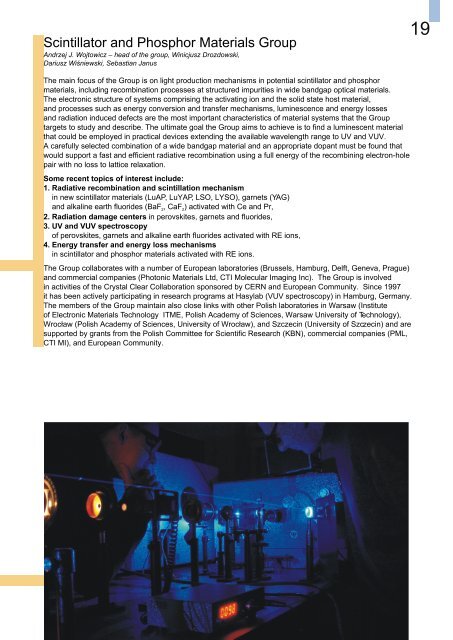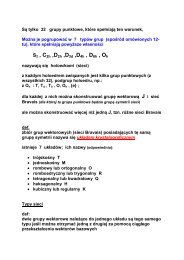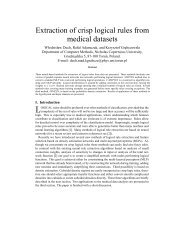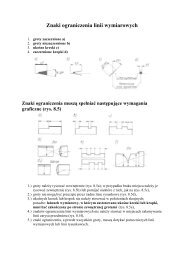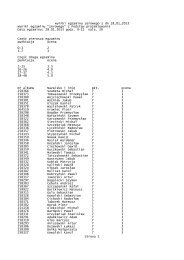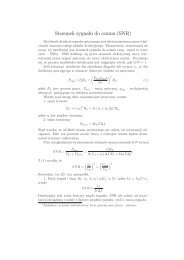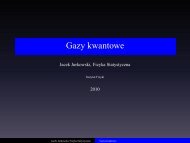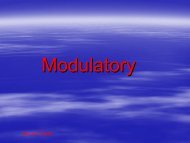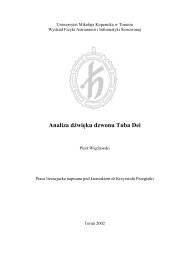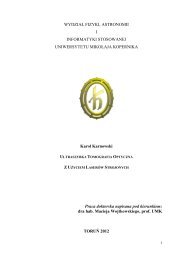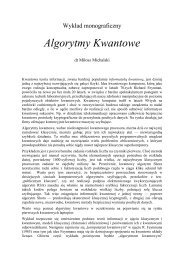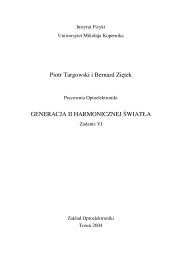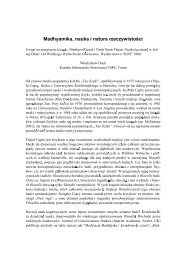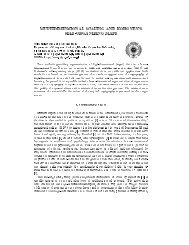Physics at Nicolaus Copernicus University
Physics at Nicolaus Copernicus University
Physics at Nicolaus Copernicus University
Create successful ePaper yourself
Turn your PDF publications into a flip-book with our unique Google optimized e-Paper software.
Scintill<strong>at</strong>or and Phosphor M<strong>at</strong>erials Group<br />
Andrzej J. Wojtowicz – head of the group, Winicjusz Drozdowski,<br />
Dariusz Wiœniewski, Sebastian Janus<br />
The main focus of the Group is on light production mechanisms in potential scintill<strong>at</strong>or and phosphor<br />
m<strong>at</strong>erials, including recombin<strong>at</strong>ion processes <strong>at</strong> structured impurities in wide bandgap optical m<strong>at</strong>erials.<br />
The electronic structure of systems comprising the activ<strong>at</strong>ing ion and the solid st<strong>at</strong>e host m<strong>at</strong>erial,<br />
and processes such as energy conversion and transfer mechanisms, luminescence and energy losses<br />
and radi<strong>at</strong>ion induced defects are the most important characteristics of m<strong>at</strong>erial systems th<strong>at</strong> the Group<br />
targets to study and describe. The ultim<strong>at</strong>e goal the Group aims to achieve is to find a luminescent m<strong>at</strong>erial<br />
th<strong>at</strong> could be employed in practical devices extending the available wavelength range to UV and VUV.<br />
A carefully selected combin<strong>at</strong>ion of a wide bandgap m<strong>at</strong>erial and an appropri<strong>at</strong>e dopant must be found th<strong>at</strong><br />
would support a fast and efficient radi<strong>at</strong>ive recombin<strong>at</strong>ion using a full energy of the recombining electron-hole<br />
pair with no loss to l<strong>at</strong>tice relax<strong>at</strong>ion.<br />
Some recent topics of interest include:<br />
1. Radi<strong>at</strong>ive recombin<strong>at</strong>ion and scintill<strong>at</strong>ion mechanism<br />
in new scintill<strong>at</strong>or m<strong>at</strong>erials (LuAP, LuYAP, LSO, LYSO), garnets (YAG)<br />
and alkaline earth fluorides (BaF 2, CaF 2)<br />
activ<strong>at</strong>ed with Ce and Pr,<br />
2. Radi<strong>at</strong>ion damage centers in perovskites, garnets and fluorides,<br />
3. UV and VUV spectroscopy<br />
of perovskites, garnets and alkaline earth fluorides activ<strong>at</strong>ed with RE ions,<br />
4. Energy transfer and energy loss mechanisms<br />
in scintill<strong>at</strong>or and phosphor m<strong>at</strong>erials activ<strong>at</strong>ed with RE ions.<br />
The Group collabor<strong>at</strong>es with a number of European labor<strong>at</strong>ories (Brussels, Hamburg, Delft, Geneva, Prague)<br />
and commercial companies (Photonic M<strong>at</strong>erials Ltd, CTI Molecular Imaging Inc). The Group is involved<br />
in activities of the Crystal Clear Collabor<strong>at</strong>ion sponsored by CERN and European Community. Since 1997<br />
it has been actively particip<strong>at</strong>ing in research programs <strong>at</strong> Hasylab (VUV spectroscopy) in Hamburg, Germany.<br />
The members of the Group maintain also close links with other Polish labor<strong>at</strong>ories in Warsaw (Institute<br />
of Electronic M<strong>at</strong>erials Technology ITME, Polish Academy of Sciences, Warsaw <strong>University</strong> of Technology),<br />
Wroc³aw (Polish Academy of Sciences, <strong>University</strong> of Wroc³aw), and Szczecin (<strong>University</strong> of Szczecin) and are<br />
supported by grants from the Polish Committee for Scientific Research (KBN), commercial companies (PML,<br />
CTI MI), and European Community.<br />
19


